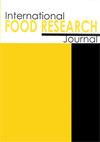植物乳杆菌对苦瓜(Momordica charantia)的生物转化及其生物活性
IF 0.7
4区 农林科学
Q4 FOOD SCIENCE & TECHNOLOGY
引用次数: 0
摘要
苦瓜以其多种生物活性而闻名,包括抗氧化、抗糖化和抗血小板聚集。然而,植物提取物的生物活性和生物利用率可能较低。通过植物乳杆菌发酵进行生物转化能够增强这些有益特性。因此,本研究旨在调查未发酵苦瓜(UBG)和发酵苦瓜在 48 小时(FBG-48)和 96 小时(FBG-96)后的汁液的物理和 pH 值、总植物化学物含量、生物活性含量和生物活性。FBG-48 的总酚含量最高,其次是 UBG 和 FBG-96。UBG 的三萜类化合物总含量最高,其次是 FBG-48 和 FBG-96。有趣的是,发酵提高了苦瓜的抗氧化、抗糖化和抗聚集活性。与 UBG 和 FBG-96 相比,FBG-48 的抗氧化和抗糖化活性最高,分别高出 10.77% 和 8.68%。同时,FBG-96 的抗糖化活性最高,提高了 60%。这可能是由于单宁酸通过生物转化转化为丁香酸,苦瓜苷 Q 通过生物转化转化为苦瓜素 P,以及对香豆酸和咖啡酸可能从细胞壁中释放出来。这些发现表明,苦瓜在治疗 II 型糖尿病并发症方面大有可为,特别是通过其抑制蛋白质聚集的活性,而且发酵可以提高其生物活性。本文章由计算机程序翻译,如有差异,请以英文原文为准。
Biotransformation of bitter gourd (Momordica charantia) by Lactobacillus plantarum and its bioactivities
Bitter gourd is renowned for its various bioactivities, including antioxidant, antiglycation, and antiplatelet aggregation. However, the bioactivity and bioavailability of plant extracts could be low. Biotransformation through Lactobacillus plantarum fermentation is capable of enhancing these beneficial properties. Therefore, the present work aimed to investigate the physical and pH profiles, total phytochemical contents, bioactive contents, and bioactivities of the juices of unfermented bitter gourd (UBG) and fermented bitter gourd at 48 (FBG-48) and 96 (FBG-96) h. Fermentation gradually altered the physical and pH profile of bitter gourd, while non-significant decrease was seen in the total flavonoid content (p > 0.05). The highest total phenolic content was observed in FBG-48, followed by UBG and FBG-96. UBG exhibited the highest total triterpenoid content, followed by FBG-48 and FBG-96. Interestingly, fermentation increased the antioxidant, antiglycation, and anti-aggregation activities of bitter gourd. FBG-48 demonstrated the highest antioxidant and antiglycation activities, with 10.77 and 8.68% higher activity, respectively, compared to UBG and FBG-96. Meanwhile, FBG-96 exhibited the highest antiglycation activity, with 60% increase. These could have been attributed to the biotransformation of tannic acid into syringic acid, and momordicoside Q into kuguacin P, along with the potential release of p-coumaric acid and caffeic acid from the cell walls. These findings demonstrated bitter gourd’s promising role in type-II diabetes complication treatment, particularly through its protein aggregation inhibition activity, and that fermentation could increase its bioactivities.
求助全文
通过发布文献求助,成功后即可免费获取论文全文。
去求助
来源期刊

international food research journal
Agricultural and Biological Sciences-Food Science
CiteScore
1.40
自引率
0.00%
发文量
75
期刊介绍:
The International Food Research Journal (IFRJ) publishes papers in English, six (6) issues a year with the coverage of:
Food Science and Technology
Nutrition and Dietetics
Agriculture, multidisciplinary
Chemistry, multidisciplinary
The scope of the Journal includes:
Food Science, Food Technology and Food Biotechnology
Product Development and Sensory Evaluation
Food Habits, Nutrition, and Health
Food Safety and Quality
Food Chemistry, Food Microbiology, Food Analysis and Testing
Food Engineering
Food Packaging
Food Waste Management
Food Entrepreneur
Food Regulatory
Post-Harvest Food Management
Food Supply Chain Management
Halal Food and Management
 求助内容:
求助内容: 应助结果提醒方式:
应助结果提醒方式:


